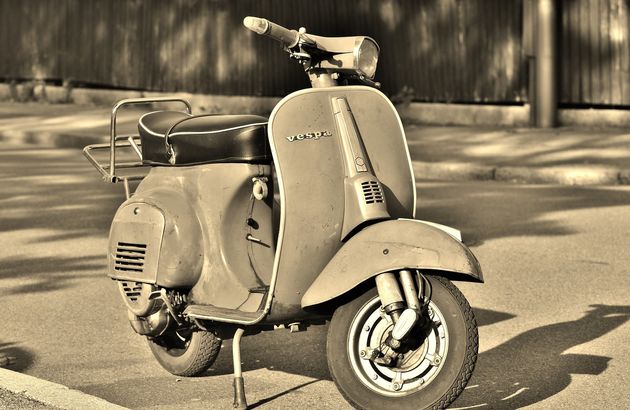
Designed just after World War II, in a bombed out aeroplane factory in Italy, the Vespa has been a classic since the day it launched
With innovative design, a shapely frame and its perfectly timed launch – plus a little help from Hollywood – the Vespa has come to signify freedom and essential Italian style. The iconic design, its name almost synonymous with the word scooter, was instantly a source of intrigue when it launched in 1946 and it quickly made a new name for aircraft manufacturer Piaggio. With its narrow waspish waist, concealed engine and lightweight design, the Vespa was quickly popular and was especially well adapted for women, who could ride the scooter in skirts because of the step-through frame.
Now well into its 70s, the Vespa’s appeal hasn’t waned and rising fuel prices and lack of parking make it a convenient option for today’s urban commuters and for buzzing around town.
The invention of a classic
The Vespa was born just after the Second World War ended in a bombed out aeroplane factory in Florence, Italy. The Piaggio factory had been dedicated to making military aeroplanes and train parts until it was severely damaged in Allied bombings and was no longer able to continue with aircraft production. On top of that, the Allied forces had put heavy caps on Italy’s aircraft industry after they won the war.
Read more: The bulbous little car that brought driving to the masses
In 1946, under the watch of engineer Enrico Piaggio (the son of the factory founder), the company turned its efforts to scooters. Piaggio would soon become one of the biggest manufacturers of scooters in the world.
Enrico Piaggio wanted to provide post-war Italians with a modern, affordable mode of transport. Two of his engineers came up with a prototype that featured a few of what became the Vespa’s innovations. The MP5, nicknamed the “Paperino” (“duckling” in Italian), had handle-mounted controls, bodywork that fully enclosed the engine, and small wheels, but it had a high central section that the rider would have to straddle.
Piaggio wasnt satisfied with the look of this early prototype and he commissioned aeronautical engineer Corradino D’Ascanio to improve on the design. D’Ascanio famously hated motorcycles, thinking of them as bulky, dirty and unreliable. He addressed these problems in his new scooter design.
Designing an appealing shape – with a practical purpose
Since the first Vespa the scooter has been known for its painted, pressed-steel unibody, which completely conceals the engine at the rear of the bike and protects the rider from dirt and grease. It also features a large mudguard and solid body that protect the driver and give them somewhere to put their feet. It has small wheels, meaning it is manoeuvrable and easy to control. It also meant that it was easy to carry a spare tyre – useful on the winding Italian roads and the post-war streets where potholes were common. It was small, cheaper and far more sexy than any motorbike on the market.
The narrow waist and sound of the engine led Enrico Piaggio to immediately proclaim, “it looks like a wasp!” The word Vespa means wasp in Italian. He christened it on the spot.
The Vespa launched in Rome in 1946 and was an instant success. Vespa Clubs popped up all around Europe and by 1952 had over 50,000 members. A few years after the scooter launched, Piaggio added a hook for a bag below the seat, modified the engine’s cooling system and added the standing leg to prop it up. The company constantly adapted and improved the Vespa. There were also several experimental models including sleek, aerodynamic racing editions as early as 1947 and even a Bazooka Vespa, built especially for the French Ministry of Defence in the mid 1950s.
Greater than any ad campaign Vespa could have come up with was the appearance of the Vespa in the film Roman Holiday, in a various scenes with Audrey Hepburn and Gregory Peck. The film reportedly led to over 100,000 sales. It also appeared in Dolce Vita, and more recently in The Talented Mr Ripley, Jamie Oliver’s TV cooking shows and Gwen Stefani’s music videos. The Vespa is still seductive today, and though many companies around the world have tried to imitate it, it is as much of a classic as ever.

















